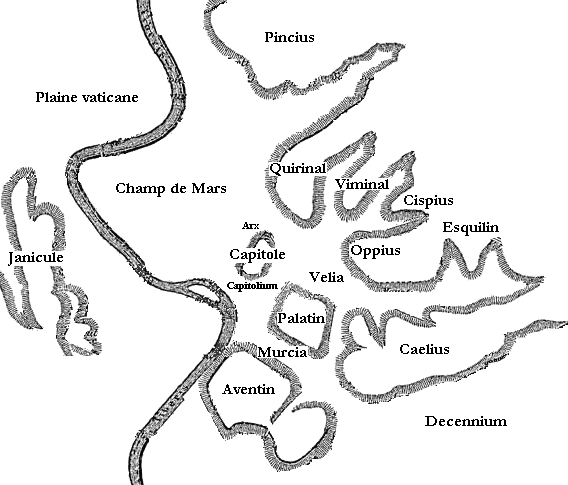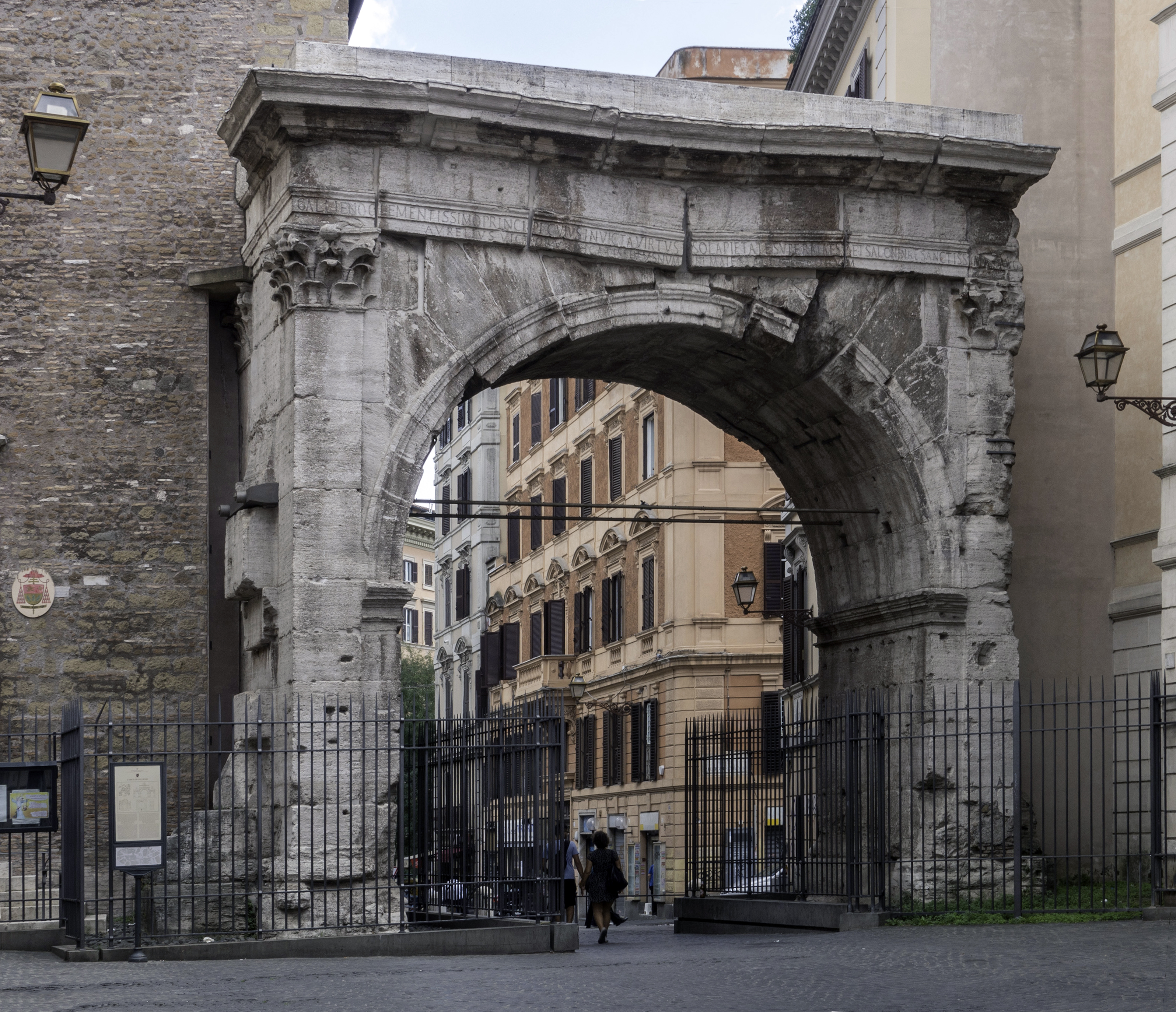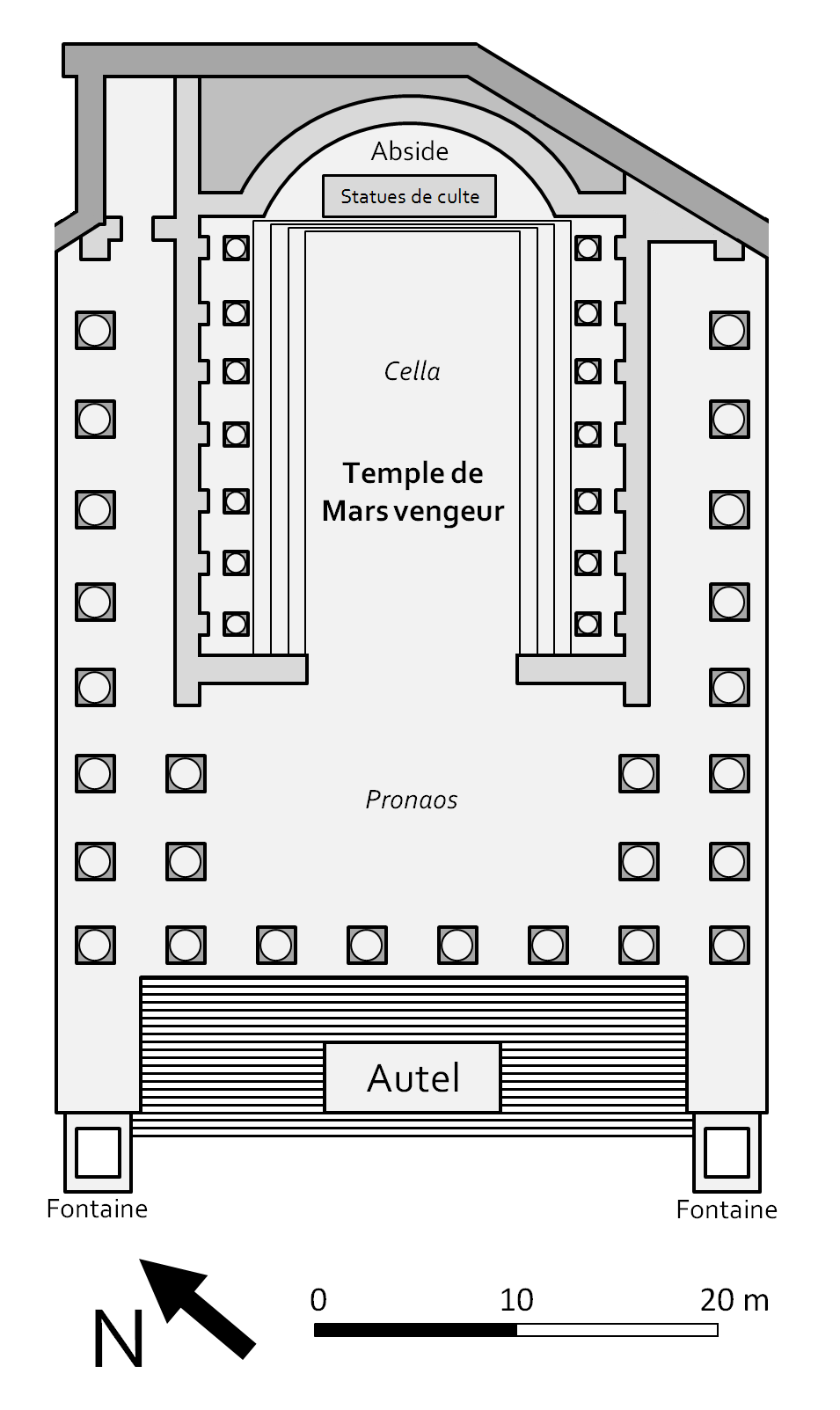|
Suburra
The Suburra, or ''Subura'' (from the latin ''Subura'') was a vast and populous neighborhood of Ancient Rome, located below the '' Murus Terreus'' on the '' Carinae'' and stretching on the slopes of the Quirinal and Viminal hills up to the offshoots of the Esquiline ( Oppian, Cispian and Fagutal hills). Since the lower part of the neighbourhood – although overlooking an area of monuments and public services – was home to an urban underclass who lived in miserable conditions, as well as a pleasure district, the term suburra has remained in the Italian language with the generic meaning of 'disreputable place", "place of ill repute" or similar. Julius Caesar lived in a family home (''domus'') in the Suburra until, in 63 BC, he was elected '' pontifex maximus'' at the age of 37. The Suburra had grown up around the property many years before his birth. The poet Martial also lived there. History The Suburra was originally part of the so-called ''Septimontium'', an area of the ... [...More Info...] [...Related Items...] OR: [Wikipedia] [Google] [Baidu] |
Regio IV Templum Pacis
The Regio IV Templum Pacis is the fourth 14 regions of Augustan Rome, regio of imperial Rome, under Augustus's administrative reform. Regio IV took its name from the Temple of Peace, Rome, Temple of Peace built in the region by the emperor Vespasian. It includes the valley between the Esquiline and the Viminal Hill, Viminal hills, the popular area of the Suburra, and the Velian Hill. Geographic extent and important features Although centred on the Temple of Peace, Rome, Temple of Peace within the Imperial Fora, Regio IV was cut in two by the Clivus Suburanus. To the north west, it was bordered by the Vicus Patricius, the Clivus Suburanus and the Servian Wall and included the Carinae. To the south east, it was bordered by the Colosseum and the Roman Forum, and included the Imperial fora and the Suburra. A measurement taken at the end of the 4th century recorded that the perimeter of the region was 13,000 Roman feet (approximately 3.84 km). When first organised by Augustus, R ... [...More Info...] [...Related Items...] OR: [Wikipedia] [Google] [Baidu] |
Vicus Patricius
Vicus Patricius was a street in ancient Rome, whose route corresponds to that of the present Via Urbana. It started from the point where the '' Argiletum'' branched into '' clivus Suburanus'' and '' vicus Patricius'', crossed the Cispian and the Viminal hills and reached the '' Porta Viminalis'' in the Servian Wall. It probably marked the border between the IV and VI regions of ancient Rome. Along its course rose the only temple of Diana to which male people had no access. There was also a ''domus'', demolished at the beginning of the reign of Antoninus Pius to erect the Baths of Novatus (''Thermae Novati'' or ''Novatianae''), which were in turn converted, not before the 4th century, into the Basilica di Santa Pudenziana. In 1848, the excavations of another large ''domus'' overlooking the ''vicus'', near the present Via Graziosa, brought to light a house of the Republican era, decorated with a fresco depicting scenes from the Odyssey The ''Odyssey'' (; ) is one ... [...More Info...] [...Related Items...] OR: [Wikipedia] [Google] [Baidu] |
Murus Terreus
The Murus Terreus Carinarum is an obscure earthwork fortification of the ancient city of Rome known from a passage in the works of Varro. The Murus Terreus may have been a part of Rome's earliest fortifications, often referred to as the Servian Wall. While the location of the ''Murus Terreus'' remains unknown and debated, it is thought likely that it belonged to the fortifications of the Oppian Hill The Oppian Hill (Latin, ''Oppius Mons''; ) is the southern spur of the Esquiline Hill, one of the Seven hills of Rome, Italy. It is separated from the Cispius on the north by the valley of the Suburra, and from the Caelian Hill on the sout ..., thus placing it between the Carinae and the Subura. Pinza suggested that the works were located on the summit of the Oppian.Pinza ''Bullettino della Commissione Archeologica Comunale di Roma'' 1898:93; 1912:86-7. References {{coord missing, Italy Walls of Rome ... [...More Info...] [...Related Items...] OR: [Wikipedia] [Google] [Baidu] |
Julius Caesar
Gaius Julius Caesar (12 or 13 July 100 BC – 15 March 44 BC) was a Roman general and statesman. A member of the First Triumvirate, Caesar led the Roman armies in the Gallic Wars before defeating his political rival Pompey in Caesar's civil war, a civil war. He subsequently became Roman dictator, dictator from 49 BC until Assassination of Julius Caesar, his assassination in 44 BC. Caesar played a critical role in Crisis of the Roman Republic, the events that led to the demise of the Roman Republic and the rise of the Roman Empire. In 60 BC, Caesar, Marcus Licinius Crassus, Crassus, and Pompey formed the First Triumvirate, an informal political alliance that dominated Roman politics for several years. Their attempts to amass political power were opposed by many in the Roman Senate, Senate, among them Cato the Younger with the private support of Cicero. Caesar rose to become one of the most powerful politicians in the Roman Republic through a string of military victories in the G ... [...More Info...] [...Related Items...] OR: [Wikipedia] [Google] [Baidu] |
Argiletum
The Argiletum (Latin ''Argīlētum''; ) was a street in ancient Rome, which crossed the popular district of Suburra up to the Roman Forum, along the route of the current Via Leonina and Via della Madonna dei Monti. On its eastern side, towards the Esquiline Hill, it branched off into the Vicus Patricius (now Via Urbana), which continued towards Porta Viminale, and the Clivus Suburanus (now Via in Selci), which climbed up to Porta Esquilina. On the western side, towards the Forum, it ended between the Basilica Aemilia and the Curia, but during the imperial age the first stretch was replaced by the Forum of Nerva, which however maintained a function of passageway and for this reason was also known as Forum Transitorium. The name of the street could derive from the clay (Latin ''Argilla'') carried by the waters that descended from the surrounding hills and then conveyed into the Cloaca Maxima. However, Varro claimed that the etymology of the term was connected with the name o ... [...More Info...] [...Related Items...] OR: [Wikipedia] [Google] [Baidu] |
Oppian Hill
The Oppian Hill (Latin, ''Oppius Mons''; ) is the southern spur of the Esquiline Hill, one of the Seven hills of Rome, Italy. It is separated from the Cispius on the north by the valley of the Suburra, and from the Caelian Hill on the south by the valley of the Colosseum. The Oppius and the Cispius together form the Esquiline plateau just inside the line of the Servian Wall. In the divisions of the Septimontium (seven hills) Fagutal appears as an independent locality, which implies that originally "Oppius" was strictly applied to this spur except the western end. The northern tip of this western end was also called Carinae, which extended between the Velian Hill and the Clivus Pullius, looked out to the southwest (across the swamps of the Palus Ceroliae towards the Aventine), incorporated the Fagutal and was one of ancient Rome's most exclusive neighborhoods. At least for religious purposes the name Oppius continued in use to the end of the Roman Republic; no later i ... [...More Info...] [...Related Items...] OR: [Wikipedia] [Google] [Baidu] |
Porta Viminale
The Porta Viminale () was a gateway in the Servian Wall of ancient Rome, at the centre of the most exposed stretch of the wall between the Porta Collina and the Porta Esquilina. These three gates and the Porta Querquetulana were the oldest in the wall. Their construction dates back to a very ancient period, around 200 years before the construction of the Servian Wall in 378 BC. It seems that the four original gates can be dated to the time of the enlargement of the city by King Servius Tullius, which added to the territory of the city, in addition to the hills already inserted between the initial seven hills, the Quirinal (), the Viminal, the Esquiline, and the Caelian (then called , meaning covered with oak woods).Strabo, Geography, V,3.7 The first defensive bulwark that connected the hills is obviously of the same period, the agger built along the whole stretch of about from Porta Collina to Esquiline, to try to defend the most vulnerable part of the city. According to s ... [...More Info...] [...Related Items...] OR: [Wikipedia] [Google] [Baidu] |
Servian Wall
The Servian Wall (; ) is an ancient Roman defensive barrier constructed around the city of Rome in the early 4th century BC. The wall was built of volcanic tuff and was up to in height in places, wide at its base, long, and is believed to have had 16 main gates, of which only one or two have survived, and enclosed a total area of . In the 3rd century AD it was superseded by the construction of the larger Aurelian Walls as the city of Rome grew beyond the boundary of the Servian Wall. History The wall is named after the sixth Roman King, Servius Tullius. The literary tradition stating that there was some type of defensive wall or earthen works that encircled the city of Rome dating to the 6th century BC has been found to be false. The main extent of the Servian Wall was built in the early 4th century BC, during what is known as the Roman Republic. Construction The Servian Wall was originally built from large blocks of Cappellaccio tuff (a volcanic rock made from ash and rock ... [...More Info...] [...Related Items...] OR: [Wikipedia] [Google] [Baidu] |
Clivus Suburanus
The Clivus Suburanus was a street in ancient Rome. It was an irregular continuation from the Subura valley, rising between the Oppian Hill and the Cispian Hill as far as the Porta Esquilina on the Servian Wall The Servian Wall (; ) is an ancient Roman defensive barrier constructed around the city of Rome in the early 4th century BC. The wall was built of volcanic tuff and was up to in height in places, wide at its base, long, and is believed to hav ...Martial, ''Epigrams'', v.22.5 and x.19.5. The remains of its paving suggest it ran along the route of the present-day via di Santa Lucia in Selci, via di San Martino and via di S. Vito. References Bibliography *Samuel Ball Platner, "Cliva", ''A Topographical Dictionary of Ancient Rome'', Oxford University Press, 1929, p. 125. Ancient Roman roads in Rome {{AncientRome-struct-stub ... [...More Info...] [...Related Items...] OR: [Wikipedia] [Google] [Baidu] |
Porta Esquilina
The Porta Esquilina (or Esquiline Gate) was a gate in the Servian Wall,Platner, S.B. and Ashby, T. ''A Topographical Dictionary of Ancient Rome''. London: Humphrey Milford Oxford University, Press. 1929 of which the Arch of Gallienus is extant today. Tradition dates it back to the 6th century BC, when the Servian Wall was said to have been built by the Roman king Servius Tullius. However modern scholarship and evidence from archaeology indicate a date in the fourth century BC.Holloway, R. Ross. ''The Archaeology of Early Rome and Latium''. London and New York: Routledge Press. 1994 The archway of the gate was rededicated in 262 as the Arch of Gallienus. Location The Porta Esquilina allowed passage between Rome and the Esquiline Hill at the city’s east before Rome expanded with the later Aurelian Wall. The Esquiline Hill served as Rome’s graveyard during the Republic and later as an area for the ''horti'' and the emperor’s most beautiful gardens such as the Gardens of Maece ... [...More Info...] [...Related Items...] OR: [Wikipedia] [Google] [Baidu] |
Temple Of Mars Ultor
The Temple of Mars ''Ultar'' was a sanctuary erected in Ancient Rome by the Roman Emperor Augustus in 2 BCE and dedicated to the god Mars in his guise as avenger. The centerpiece of the Forum of Augustus, it was a peripteral style temple, on the front and sides, but not the rear (''sine postico''), raised on a platform and lined with eight columns in the Corinthian order style. According to Suetonius and Ovid, the young Octavian vowed to build a temple to Mars in 42 BCE just before the Battle of Philippi if the god would grant him and Marcus Antonius victory over two of the assassins of Julius Caesar, Gaius Cassius Longinus and Marcus Junius Brutus. However, work did not commence on the temple until after the recovery of the ''Aquilae'' in 20 BCE that had been lost by Marcus Licinius Crassus in the disastrous Battle of Carrhae 33 years earlier. Originally, the Roman Senate had decreed that the returned standards were to be housed in a temple to Mars ''Ultor'' that was to be b ... [...More Info...] [...Related Items...] OR: [Wikipedia] [Google] [Baidu] |
14 Regions Of Augustan Rome
In 7 BC, Augustus divided the city of ancient Rome, Rome into 14 administrative regions (Latin , ). These replaced the four —or "quarters"—traditionally attributed to Servius Tullius, sixth king of Rome. They were further divided into official neighborhoods (). Originally designated by number, the regions acquired nicknames from major landmarks or Topography of ancient Rome, topographical features within them. After the reign of Constantine the Great, the imperial city of Constantinople was also divided into fourteen ''regiones'', on the Roman example: the 14 regions of Constantinople. History of Rome's regions Evidence of regions in Rome before Augustus is limited. Writing in the mid-40s BC, Marcus Terentius Varro describes four 'partes urbis', referring to them individually as a ‘regio’ with both names and numbers: I Suburana, II Esquilina, III Collina and IV Palatina. Varro also provides evidence for vici in Republican Rome, deriving the word vicus from via and w ... [...More Info...] [...Related Items...] OR: [Wikipedia] [Google] [Baidu] |






